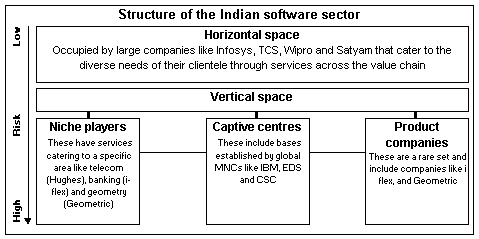
Home > Business > Special
Software: The 'risk-return' matrix
September 07, 2004
Stocks from the IT industry are considered to be a defensive play since companies in the sector are 'assumed' to be insulated from the vagaries of inflation and rise in interest rates. However, there is a need to understand that all players in the technology space are not insulated from these uncertainties. In order to arrive at any decision, one needs to understand the structure of the Indian software industry through a broad classification of all its constituents (companies). Based on respective size and abilities, software companies can broadly be categorised into the structure as mentioned in the chart below.  Source: Geometric Software's 2003-04 Annual Report Source: Geometric Software's 2003-04 Annual ReportHorizontal space: Large players like Infosys, TCS, Wipro, HCL Tech and Satyam occupy this space. These companies have offerings that span almost the entire value chain, or a major part of it and, as such, have the ability to cater to a diverse set of clientele. Another basic characteristic of this set of companies is their large scale -- large number of development centres, global sales offices and a large employee base. We believe that these companies are most likely to gain from the increased wave of outsourcing, as they have proven capabilities in areas like scalability and de-risked business models (offer end-to-end services). Although MphasiS do not have many services that match with the top rung players, the fact that it is a quality software service provider along with a BPO offering puts it in the horizontal space.  Vertical space: This category is further divided into three distinct parts: Niche players: These are players that have a focused presence in one particular area or domain. Prominent examples in this segment are i-flex (provides services and products in the banking and financial services industry), Hughes Software (provides solutions to the global telecom industry) and Geometric Software (provides solution for engineering and manufacturing companies). As compared to the large players, companies in this category are more prone to uncertainty. This is because they derive almost their entire revenues from a single domain, and any upheaval in that space causes volatility in their financial performance and valuations. For instance, Hughes Software, which earlier provided services only to telecom OEMs (original equipment manufacturers) faced grim times in the years 2001, 2002 and 2003. This was because, facing pressure of unutilized capacities due to a decline in telecom spending during these years, these OEMs cut down on their outsourcing of telecom R&D services. And this proved ominous for Hughes Software. As a matter of fact, Hughes' revenues grew at a CAGR of 5% during these three years, with 2003 actually witnessing a decline. Captive centres of global MNCs: These represent the bases established by global MNCs like IBM, EDS and CSC in India with a view of taking advantage of the low-cost Indian offshoring model. Now, these captives present the toughest challenge to the large Indian offshoring companies that occupy the horizontal space. This is because, backed by their high domain capabilities, these companies have been posing a grave threat to the large Indian players in key areas like client acquisition and talent retention. Relatively higher salaries paid by these captive companies have been one of the leading causes of the increase in attrition levels for Indian players, especially at the top level. Product companies: As mentioned earlier, these are a rare species in the Indian context. This is vindicated from the fact that we have only a few globally recognised players in the product space. And the most prominent among these very few is i-flex solutions, the leading provider of core banking solutions. The company, with its flagship product, Flexcube, has been at the forefront of bringing global recognition to the 'Made in India' brand. Other key players in the products space are Hughes Software and Geometric Software, though both have only a minor part (16% and 11% respectively) of their revenues coming from this segment. Also, while i-flex has a product that spans the entire requirement of the client, the latter two companies largely cater to OEMs through small components like plug-ins and add-ons. Being a successful product company has one key advantage attached to it. That is, after a point of time, once the company has established its presence through a quality product, revenues from the same follow straight to the bottomline, as incremental expenses towards products are very minimal as compared to services. This is not true for a services player because a services company has to make continued initiatives towards moving up the value chain or it has to continuously invest in human resources if it wants earn higher revenues. Coming back to our point that all players in the Indian technology space are not insulated from the turn of events outside their realm, we believe that going forward, demand for technology solution from global clients is likely to be concentrated among a few players. These could be any of those discussed above. This is because the demand for technology is likely to be more guided by the 'Return on Investment' factor, i.e., how much of cost saving or return on investment can be obtained by clients from their IT spending. And, in these circumstances, companies in the horizontal space are less risky as compared to focused (vertical) companies. Investing in vertical companies purely depends on the investor's risk-return profile, as the risks are higher. Equitymaster.com is one of India's premier finance portals. The web site offers a user-friendly portfolio tracker, a weekly buy/sell recommendation service and research reports on India's top companies. 
|